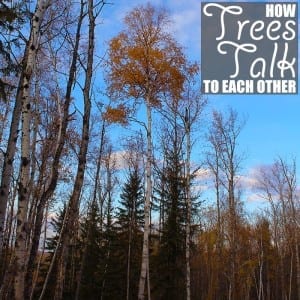 We all know trees are living organisms, but did you know they can talk? I read Jane Goodall’s Seeds of Hope last year and was absolutely entranced with the chapter on trees (surprise, surprise, given the name of this blog). In my favourite section she talked about the ability trees have to communicate through their underground network of roots.
We all know trees are living organisms, but did you know they can talk? I read Jane Goodall’s Seeds of Hope last year and was absolutely entranced with the chapter on trees (surprise, surprise, given the name of this blog). In my favourite section she talked about the ability trees have to communicate through their underground network of roots.
Then, only a few months later, I was YouTubing it up one night and came across a TEDTalks by Suzanne Simard about – you guessed it – the communicative abilities of trees.
THEN, a few months after that, I was at the bookstore and the woman in front of me at the cash register was buying a copy of a book called The Hidden Life of Trees by Peter Wohlleben. Clearly someone was trying to tell me something. Perhaps it was the trees.When we built the road on our land, the tree hugger inside of me reared it’s passionately idealistic head. The previous owner had already cleared a path through the forest where they thought the road should be and we agreed it was the best location. However, I pleaded that every single remaining tree be preserved – regardless of the fact that substantial elevation changes made this a near impossible feat. (I say “near” because, of course, there was one way of making it possible – don’t build a road.)
As I’ve previously written, the finished road is beautiful and we preserved as many trees as we could and – as I always say – we believe the land was sent to us because we would care for it in a way that the majority of other’s would not, meaning a few trees were gone, but many more remained and we intended to keep it that way. Still, I mourn for every single lost tree. At the time, I couldn’t explain why. But now I can.
“Underground there is this otherworld,” says Simard in her TEDTalk How Trees Talk To Each Other. “A world of infinite biological pathways that connect trees and allow them to communicate and allow the forest to behave as though it were a single organism.”
Twenty-five years ago, Simard had a hypothesis about how trees talk to each other. She began conducting field experiments to see if a tree would pass injected tracer isotope carbon dioxide gases to another tree. This may not sound that exciting, but it was actually quite controversial at the time. When Simard discovered that trees were “not only conversing in the language of carbon,” they were also communicating via nitrogen, phosphorous, water, chemicals and hormones – it was a revelation.
Furthermore, certain trees within a forest were responsible for the majority of the communication. Referred to as “mother trees,” they are often the largest in a forest. Scientists now know that mother trees send carbon to seedlings within a forest, which increases their survival by four times. Mother trees even favour their own offspring seedlings rather than “stranger seedlings” and show their preferential love by sending them more carbon, creating larger underground pathways to communicate with them and reducing their own roots to make room for their children to grow. I don’t know about you, but that makes me tear up a bit.
If that doesn’t get you misty, then how about this? Injured or dying mother trees send the knowledge they’ve gleaned over their long years to their seedlings in hopes the little trees will avoid the same fate. And it works! Scientists have actually found that these distress signals help the seedlings resist future stresses.
And now for a sobering fact. In 2014, the World Resources Institute reported that Canada over the last ten years has had the highest forest disturbance rate out of any country in the world. As Simard notes, “a massive disturbance at this scale is known to effect hydrological cycles, degrade wildlife habitat and emit greenhouse gases back to the atmosphere, which creates more tree disturbances and more die-backs.”
Thankfully, Simard is not a pessimist and neither am I. There is always a way. A way to do better. Be better. And take better care of our planet and all the wonderful things that call earth home. Here are four ways Simard believes we can help our forests retain their collective knowledge.
Re-establish local involvement. Manage forests based on local conditions, not on a one-size-fits all approach.
Save old-growth. Preserve mother trees, which preserves their genes and wisdom.
Cut thoughtfully. Keeping mother trees means keeping their ability to nurture new-growth trees.
Retain diversity. Respect the intelligence that forests have instead of bending them to our will by weeding out “unfavourable” species.
The more I learn about the current state of our environment and the choices we must make to preserve it, the clearer it becomes that my fondness for trees is more than a quirk. Instead, it’s a deep root connected to a vast network that is much, much, larger than me.
What are your thoughts on how trees talk to each other? Have you ever had to cut down a tree (or several)? Do you have any suggestions for how we can better care for our forests – or even just individual trees? Let’s have a deep and meaningful conversation about it in the comments and then go hug a birch or something.
LET’S BE TREEHUGGERS TOGETHER!
Subscribe to have weekly treehugger tips + the latest Of Houses and Trees posts delivered directly to your inbox!
OH, AND LET’S BE FRIENDS TOO…
PIN ME!
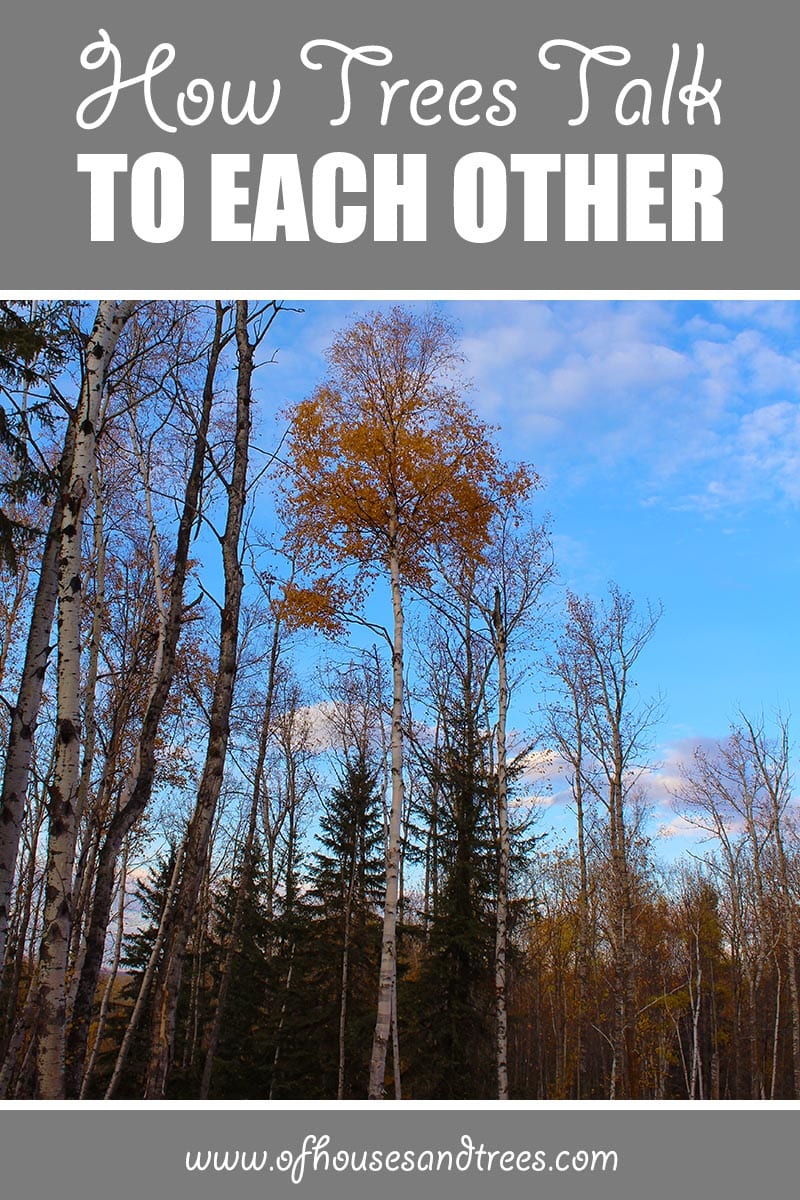
Posted on March 19, 2017 (Last Updated on March 22, 2020)
Former architectural technologist. Current treehugger.
I’m here to help you green your home – and your life.
Subscribe to the Of Houses and Trees monthly newsletter and I’ll send you my FREE list of “The 8 Best Places to Buy Eco-Conscious Decor Online.”
What on earth is sustainable design? Learn all about this eco-focused design method and read the latest posts about green architecture, interior design and decor.
Sustainable living is more than just a thing treehuggers talk about. It’s about making conscious choices everyday. Read the latest posts on living with the planet’s wellbeing always in mind.
Visit the Of Houses and Trees sustainable product directory and support brands trying to make a difference in the world.
Find out more about our 40 acres of land in Parkland County, Alberta and the sustainable home we built amongst the trees.
Need help creating the home of your dreams? Care about the planet? You’ve come to the right place! check out my affordable, sustainable e-design services.
Having a had time choosing paint colours? I’ve got you – and your walls – covered with an interior paint palette sure to compliment your home.
Have questions about creating an eco-conscious home? Go ahead – ask me! Sign up for one of my free online interior design consultations and ask me anything you want.


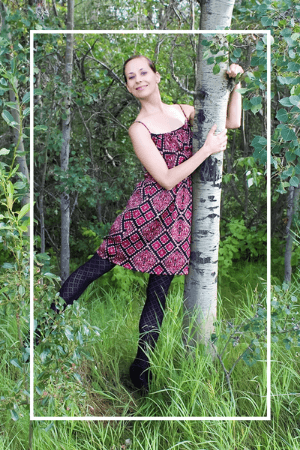
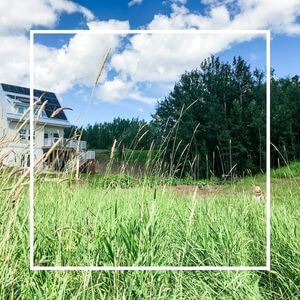
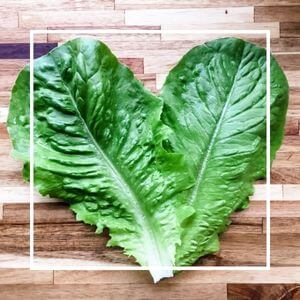
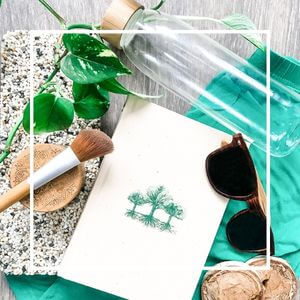


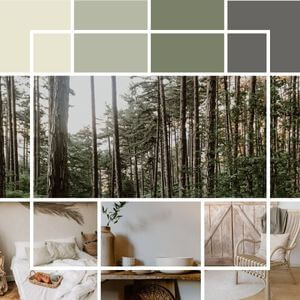
I share your love of trees. I currently lack them on my piece of land but I covet and love the ones that live across the road. I IG trees second only to my Rottweiler. You know. The fur baby. I’m happiest surrounded by leaves and I’m so glad to know they join forces and have familial relationships. This makes me happy. For now I’m living without them around me but there is one that I can gaze at from my bathroom window while busy doing um bathroom stuff. Random. I know. Love your blog keep it up sweet girl.
Your land is lovely though even though it’s sans trees and I also must say how much I appreciate that you’re usually the first one to comment on new posts. You are both thoughtful AND totally on the ball. A winning combo!
I was actually reading a part of Conversations in the Forest, by Suzzane, the other day. It was linked to another article about ecology and how it may be possible to teach trees in some areas to become more resistant to environmental changes by taking saplings from particularly drought areas and planting them in areas that may now be seeing drought-like conditions. Thus the trees will teach the other trees to survive the new environment. I find this stuff fascinating. I started to learn more about how fungus greatly increases the vast communication network by allowing the distance in the forest between “mother trees” and either the same or different species of trees. Its like one big family of nature, and I want to be part of it. I could talk for hrs on this topic. Maybe we will one day.
Great article!!
I meant to say that fungus helps the entire community of trees stay connected over the distances.
This is so flippin’ cool. It makes me feel small in a good way like when standing next to the ocean that there are things in the world so much bigger than me, but at the same time I too am connected to them. Thanks for the awesome comment!